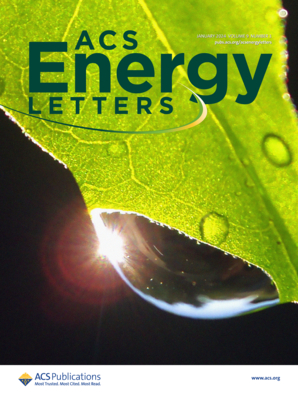Multisite Coordination Ligand Strategy for FAPbBr3 Nanocrystal Light-Emitting Diodes
IF 19.3
1区 材料科学
Q1 CHEMISTRY, PHYSICAL
引用次数: 0
Abstract
Passivation strategies have been proven to improve the optoelectronic properties of perovskite nanocrystals (PNCs) and to suppress their ion migration; however, previous studies have predominantly focused on their binding affinity to uncoordinated Pb2+ ions, overlooking additional interactions with monovalent cations. Here, we introduce multisite coordination ligands (composed of multiple fluorine atoms) to achieve additional interactions with formamidinium lead bromide (FAPbBr3) PNCs. One fluorine atom passivates an uncoordinated Pb2+ ion, while the other fluorine atoms form hydrogen bonds with the surrounding FA+ ions, thereby strongly binding to the PNC surface and suppressing ion migration. This strong passivation enables postsynthetic ligand exchange using polar solvents without compromising the optoelectronic properties of PNCs by protecting them from polar solvents. As a result, we achieve efficient PNC-LEDs with a maximum external quantum efficiency (EQE) of 25.2% at a luminance of 4474 cd m–2, maintaining an EQE of over 20% up to approximately 8000 cd m–2.

求助全文
约1分钟内获得全文
求助全文
来源期刊

ACS Energy Letters
Energy-Renewable Energy, Sustainability and the Environment
CiteScore
31.20
自引率
5.00%
发文量
469
审稿时长
1 months
期刊介绍:
ACS Energy Letters is a monthly journal that publishes papers reporting new scientific advances in energy research. The journal focuses on topics that are of interest to scientists working in the fundamental and applied sciences. Rapid publication is a central criterion for acceptance, and the journal is known for its quick publication times, with an average of 4-6 weeks from submission to web publication in As Soon As Publishable format.
ACS Energy Letters is ranked as the number one journal in the Web of Science Electrochemistry category. It also ranks within the top 10 journals for Physical Chemistry, Energy & Fuels, and Nanoscience & Nanotechnology.
The journal offers several types of articles, including Letters, Energy Express, Perspectives, Reviews, Editorials, Viewpoints and Energy Focus. Additionally, authors have the option to submit videos that summarize or support the information presented in a Perspective or Review article, which can be highlighted on the journal's website. ACS Energy Letters is abstracted and indexed in Chemical Abstracts Service/SciFinder, EBSCO-summon, PubMed, Web of Science, Scopus and Portico.
 求助内容:
求助内容: 应助结果提醒方式:
应助结果提醒方式:


